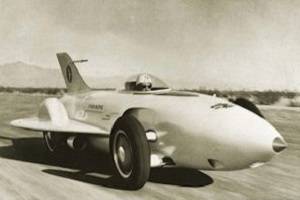You couldn’t buy it, much less drive it on the road, but General Motors was determined to prove its faith in the future with this winged wonder powered by America’s first automotive gas turbine.

General Motors Firebird XP21 1954
- YEAR REVEALED 1954
- PLACE OF ORIGIN Detroit, Michigan
- HISTORICAL STATUS prototype
- ENGINE gas turbine
- MAXIMUM POWER 370bhp
- LAYOUT rear-mounted engine driving the rear wheels
- BODYWORK canopy-entry, single-seater coupé
- TOP SPEED unknown
- NUMBER BUILT one
General Motors hired the Indianapolis Speedway for a day, where the car’s project leader Emmett Conklin had driven it at up to 100mph (161kph) before the tires lost traction and his nerve broke. The Firebird was not for the faint-hearted: the 370bhp “Whirlfire Turbo-Power” turbine behind the driver ran at a blurry 13,300rpm, taking its power from compressed gas burned in a gasifier which spun at 26,000rpm; the exhaust reached temperatures of 1,251°F (677ºC); and braking came from drums on the wheels and flaps in the “wings”.
The Firebird toured the US as part of the 1954 Motorama roadshow, feeding the public’s “jet age” obsession. The styling of this aircraft-on-wheels easily met “wow factor” expectations. The work of legendary GM design chief Harley Earl, it was fashioned after the Douglas Skyray supersonic plane and made from fiberglass, like the brand new Chevrolet Corvette.
The plastic cockpit bubble was pure B-movie science fiction. A year later, Firebird II was unveiled, a four-seater, rendering the XP-21, retrospectively, Firebird I. Claiming “the future is our assignment,” General Motors presented the two-seater Firebird III in 1958 which, with its refined drivetrain, cruise control, and anti-lock brakes was even more of a rolling laboratory than its predecessors.